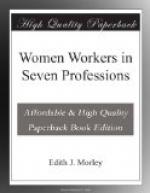(2)that the bogey of sex cleavage, so often mentioned by the timorous in the political world, is here, as always where it is put to the test, proved to be without foundation.
Unfortunately, the Insurance Act divided the medical profession into two parties; women, no more than men, were unanimous on the subject and some were to be found on either side.
Women are still debarred from the full use of their medical powers in the following ways:—
(1) The demand for their services from the general public is at present not so great nor so universal as that for men. This is not surprising when it is realised for how short a time there have been medical women; however, the demand on the part of the public is very rapidly increasing, naturally, of course, amongst their own sex.
(2) As in other work the tendency is to restrict women to the lower branches of public work, or to the so-called “blind alley” occupations. This can only be cured by public demand, and some improvement is to be noted in this respect. There is, however, no doubt that general practice affords at present the most unrestricted field for a medical woman’s activity, because there she suffers from no limitations except those of her own personality in relation to society. Any patients who are inclined to trust her are absolutely free to do so, and it is open to her to demand what fees her services are found to be worth.
If, on the other hand, she enters the public service she may admittedly qualify herself in every way by attainments and experience in the lower ranks for one of the higher administrative posts and be barred simply by sex disqualification. This also will no doubt in time improve, and the pioneer work that it implies may attract many, but the progress is necessarily slower.
(3) She is still debarred from full opportunity for specialist work. (See efforts being made by women themselves to obviate this by the starting of women’s hospitals, p. 149.)
Finally, then, the medical profession should attract women of good average capacity and general education, good health and certain, even if moderate, means. Above all do they need public spirit, which will make them anxious to maintain and improve the excellent position medical women have so far obtained. It is a very widely interesting life, bringing those who adopt it out of the study into direct touch with human affairs.
[Footnote 1: Publisher, G. Sharrow, 28A Devonshire Street, Portland Place, W.]
[Footnote 2: Quite recently the outline of a new scheme was put before a meeting at the Women’s Medical School in London by the Director-General of the Indian Medical Service. Under this scheme the Women’s Medical Service in India would not be upon the same footing as the Indian Medical Service (I.M.S.) for men, but would remain as at present, a Dufferin Association. It would, however, receive a Government grant of L10,000 yearly, and proper arrangements would be made for pay, furlough, promotion, and security of tenure. The scheme is open to criticism on some points, but, as a whole, it marks a considerable advance on the previous conditions of service in this department of women’s work, and may be welcomed as a genuine if somewhat belated attempt on the part of the Government to deal fairly with an urgent question.]




